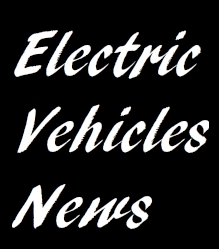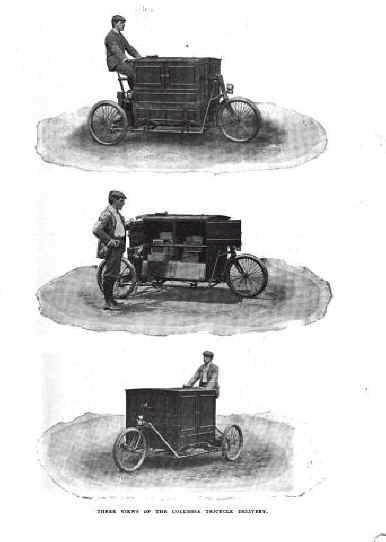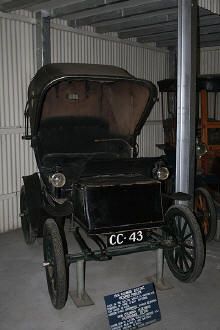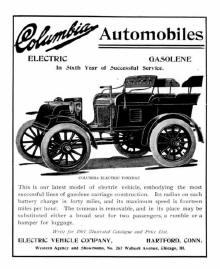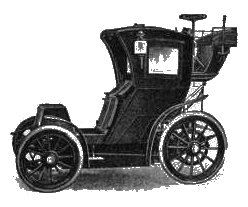Columbia Automobile Company
The Columbia Automobile Company, located on Hartford, Connecticut, was a leading US manufacturer of automobiles created in 1899 as a joint venture of the Motor Vehicle Division of the Pope Manufacturing Company and the Electric Vehicle Company. At the turn of the Twentieth century they were producing and selling hundreds of vehicles a year under Pope's Columbia brand name, while most gasoline engine automobile manufacturers had made only a few dozen.
In 1908, the company was renamed the Columbia Motor Car Co. and in 1910 was acquired by United States Motor Company. The United States Motor Company (USMC) was organized by Benjamin Briscoe in 1910 as a selling company, to represent various manufacturers. Those companies included: Maxwell, Stoddard-Dayton, Courier Car Co, Columbia Automobile Company, Brush Motor Car Company, Alden Sampson Trucks, Gray Marine, and Providence Engineering Works, with the Thomas and other lines coming aboard later. Electric models
The 'Columbia Surrey' and 'Columbia Victoria' were more traditional horseless carriages. Both used the same power system as the larger cars, with twin electric motors, but cost much less at USD $1500 and USD $1600, respectively. At the bottom end of the range was the 'Columbia Runabout' car. Priced at just US$750, it used a single electric motor, with an Exide battery and Concord springs. Columbia's basic runabout was typical of the time, resembling a horseless carriage, and was steered via a tiller. It cost US$850, $200 more than the contemporary Curved Dash Oldsmobile. The 1,200-pound (540 kg), single bench seat vehicle had a wheelbase of 64 inches (1,600 mm), and rode on 30-inch (760 mm) wooden spoked wheels, with leather fenders. The drivetrain had clear evolutionary roots in Pope's bicycle business, driving the rear axle via a chain drive, producing virtually the only operating noise. Between the motor and the chain drive was a transmission with three forward and two reverse speeds. Twenty batteries manufactured by Exide Batteries, also associated with Electric Vehicle Company, were placed above both axles in order to balance the weight. Brakes on both rear wheels featured a bell, which rang when the vehicle reached a full stop. Top speed was about 15 mph (24 km/h). Besides the runabout, Columbia manufactured about 20 other electric vehicles, including taxis and police cars, and even electric buses. The vehicles were most popular in cities, where relatively smooth roads made the electric motor, with its smoothness and silence, appear superior over the gasoline engine. It helped in urban areas that electrical supply for recharging was easily found within the runabout's 40-mile (64 km) range. Nevertheless, in 1903, a Columbia was driven 250 miles (400 km) from Boston to New York City in 23 hours. In keeping with this urban orientation, the Columbia was positioned as a high-end vehicle, with its showroom across the street from the Metropolitan Opera House in New York. In early 1912, USMC suspended dividend payments on its preferred stock and in September 1912 year went into receivership. The bankers attributed the failure to bad management. A conflict between two of its backers, who also had a financial interest in General Motors, led to the downfall. Briscoe retired in late 1912 and was replaced by Walter E. Flanders as manager for the receivers committee. The assets of the United States Motor Company and constituent companies were sold for $7,080,000 at a public foreclosure sale in January 1913.
The USMC assets were purchased by Walter Flanders, who reorganized the company as the Maxwell Motor Company, Inc. This was the only surviving member of the group. In the early 1920s this company was reorganized and became Chrysler.
Some extracts From Wikipedia, the free encyclopedia: Text is available under the Creative Commons Attribution-ShareAlike License; additional terms may apply. See Terms of Use for details. |
|||||||||||
